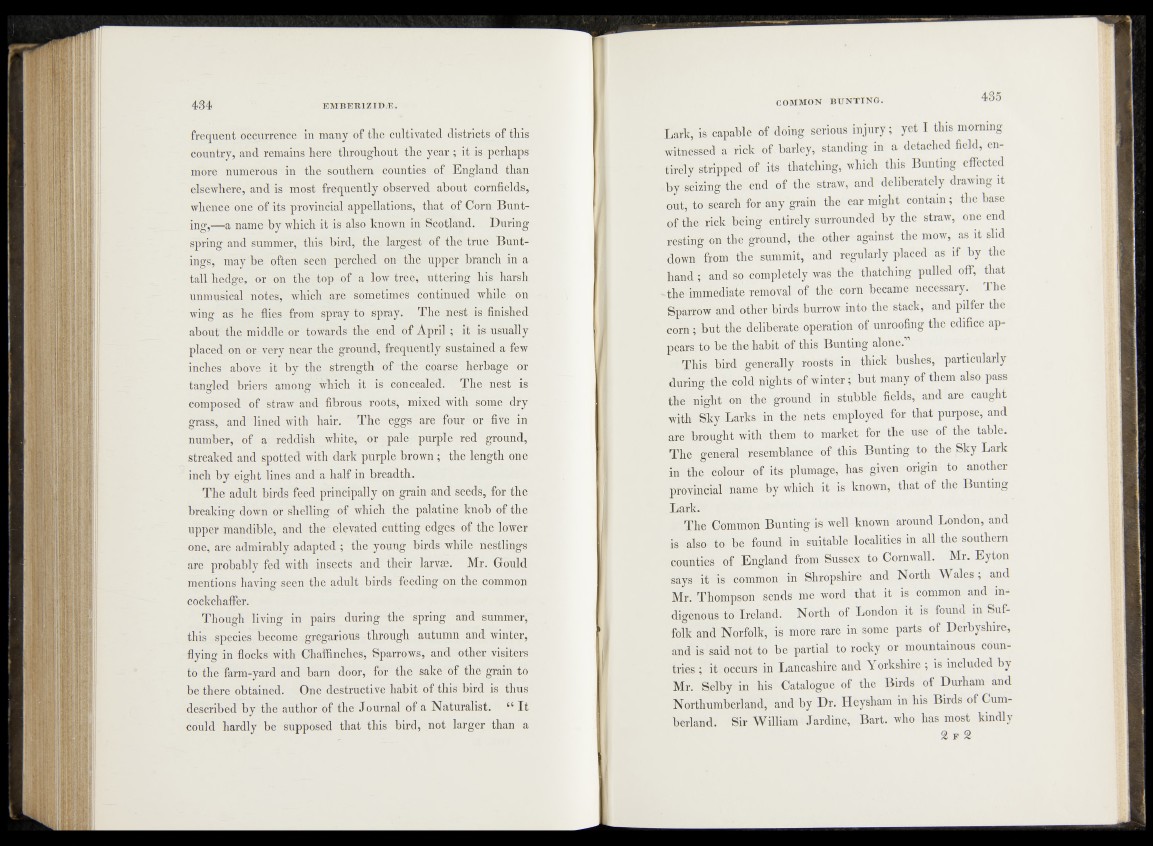
frequent occurrence in many of the cultivated districts of this
country, and remains here throughout the year ; it is perhaps
more numerous in the southern counties of England than
elsewhere, and is most frequently observed about cornfields,
whence one of its provincial appellations, that of Corn Bunting,—
a name by which it is also known in Scotland. During
spring and summer, this bird, the largest of the true Buntings,
may be often seen perched on the upper branch in a
tall hedge, or on the top of a low tree, uttering his harsh
unmusical notes, which are sometimes continued while on
wing as he flies from spray to spray. The nest is finished
about the middle or towards the end of April ; it is usually
placed on or very near the ground, frequently sustained a few
inches above it by the strength of the coarse herbage or
tangled briers among which it is concealed. The nest is
composed of straw and fibrous roots, mixed with some dry
grass, and lined with hair. The eggs are four or five in
number, of a reddish white, or pale purple red ground,
streaked and spotted with dark purple brown ; the length one
inch by eight lines and a half in breadth.
The adult birds feed principally on grain and seeds, for the
breaking down or shelling of which the palatine knob of the
upper mandible, and the elevated cutting edges of the lower
one, are admirably adapted ; the young birds while nestlings
are probably fed with insects and their larva?. Mr. Gould
mentions having seen the adult birds feeding on the common
cockchaffer.
Though living in pairs during the spring and summer,
this species become gregarious through autumn and winter,
flying in flocks with Chaffinches, Sparrows, and other visiters
to the farm-yard and bam door, for the sake of the grain to
be there obtained. One destructive habit of this bird is thus
described by the author of the Journal of a Naturalist. “ It
could hardly be supposed that this bird, not larger than a
Lark, is capable of doing serious injury; yet I this morning
witnessed a rick of barley, standing in a detached field, entirely
stripped of its thatching, which this Bunting effected
by seizing the end of the straw, and deliberately drawing it
out, to search for any grain the ear might contain ; the base
of the rick being entirely surrounded by the straw, one end
resting on the ground, the other against the mow, as it slid
down from the summit, and regularly placed as if by the
hand ; and so completely was the thatching pulled off, that
-the immediate removal of the corn became necessary. The
Sparrow and other birds burrow into the stack, and pilfer the
corn ; but the deliberate operation of unroofing the edifice appears
to be the habit of this Bunting alone.”
This bird generally roosts in thick bushes, particularly
during the cold nights of winter; but many of them also pass
the night on the ground in stubble fields, and are caught
with Sky Larks in the nets employed for that purpose, and
are brought with them to market for the use of the table.
The general resemblance of this Bunting to the Sky Lark
in the colour of its plumage, has given origin to another
provincial name by which it is known, that of the Bunting
Lark.
The Common Bunting is well known around London, and
is also to be found in suitable localities in all the southern
counties of England from Sussex to Cornwall. Mr. Eyton
says it is common in Shropshire and North Wales; and
Mr. Thompson sends me word that it is common and indigenous
to Ireland. North of London it is found in Suffolk
and Norfolk, is more rare in some parts of Derbyshire,
and is said not to be partial to rocky or mountainous countries
; it occurs in Lancashire and Yorkshire ; is included by
Mr. Selby in his Catalogue of the Birds of Durham and
Northumberland, and by Dr. Heysham in his Birds of Cumberland.
Sir William Jardine, Bart, who has most kindly
2 f 2